It’s a parent’s worst nightmare – your very young child needs their first filling. Visiting the dentist is an unpleasant experience for even the most mature of people, but can be especially challenging for the very young child. How can a parent help their young child with a first filling? What works and what doesn’t?
This week I’m taking a break from talking about pregnancy and childbirth to share with you what’s worked for me and my three kids when it comes to getting a first filling. Sigh. I wish I didn’t have the experience needed to write this blog post, but I do. If you find yourself in this unfortunate situation – your kids have a cavity and need their first filling – it’s going to be ok. You’ll get through this, I promise.
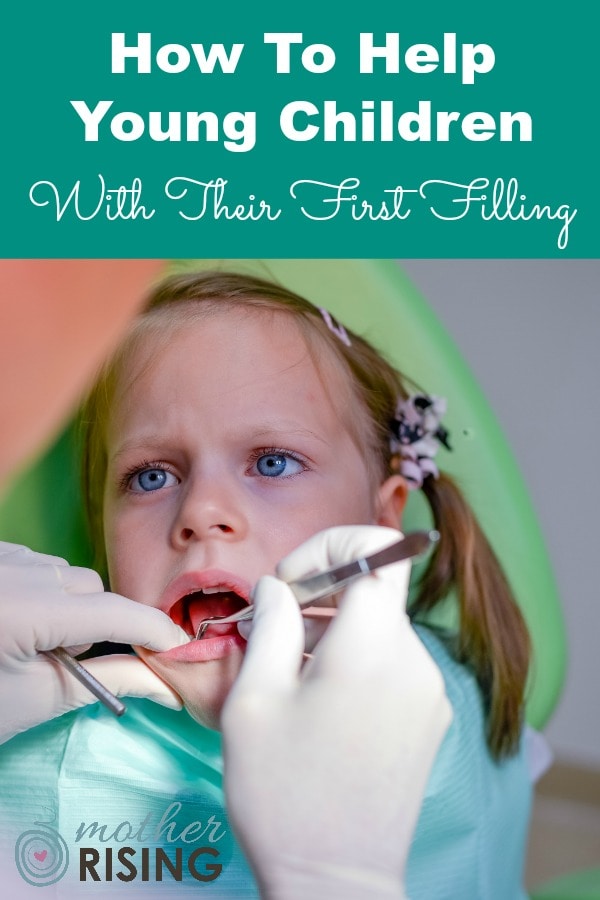
How To Help Young Children With Their First Filling
In this blog post I share about my experience with helping my kiddos with their first filling, but won’t shame you as a parent, point the finger, or even talk about how to avoid cavities in the first place. For whatever reason, you’ve found yourself on this website because you need to do what needs to be done – get dental work done for your child(ren). I hope you find some good advice and are able to successfully help your child have a gentle experience at the dentist with minimal medical intervention.
A Tailored Approach
It’s important to note that one approach to helping young children with their first filling will not work for all. Just as each person is uniquely and wonderfully made, so are your children and their specific needs during this stressful time. In this blog post, take what works for you and your family, and leave the rest.
If helping your child get their first filling is in your future, I will say that it is incredibly important to be proactive in the process. The fact that you’re here reading this article is a sign that you’re up to this challenging task. Good job!
The following advice is what’s worked for me and my three children over the years while they were very young getting their first filling.
One-On-One
The first tip for helping young children with their first filling is to always have a parent or guardian available that can give undivided attention during an appointment. This is sometimes not an option (been there, done that) but if possible, being available and having the ability to be all in, in any given moment, makes a huge difference.
The first time my oldest child had dental work done was when he was three years old. I had been putting off getting dental work done throughout his twos because he was just so young. I did not think him capable of coping through an appointment without general anesthesia, and I desperately wanted to avoid that sort of procedure. Not only is general anesthesia SO EXPENSIVE, it is also a pretty invasive procedure that has its risks.
By the time he was three and a half, I could put off dental work no longer as his teeth had begun to give him discomfort. However, I was also ginormously pregnant and due within a week. But I did what any mama would do and brought him in to see the dentist to make a plan. The plan was for 1) me to give birth that week and then 2) come in the following week. Which is exactly what we did.
So no, I was not able to give my three year old one-on-one attention at his appointment, however, a one week old newborn can sometimes be super easy and sleep the whole appointment. It wasn’t ideal, but we made it work.
Go Once “For Fun”
One thing that helps the very young with their first filling is to visit the dentist before getting a cavity filled just for fun. Call the dentist office to see if they schedule short tours for families with young children. This is a non-threatening way to introduce a child to the world of dentistry. Bonus points if they’re able to see another (calm) child getting a cleaning or dental work done!
When I recently brought my three year old to the dentist for the first time it was for a cleaning. Really, we had low expectations for her and it was mostly for the sake of de-sensitizing her to this new and strange place. It didn’t go well. In the end we were able to let the dentist brush her teeth a tiny bit, but in no way would I say she was comfortable or happy about what happened. There were tears. She didn’t have fun.
However, in the end she did realize that nothing bad or painful happened and children get cool things like toothbrushes, floss, and stickers (prizes are a BIG DEAL people!) after appointments. She was also able to touch the nose piece for the nitrous oxide. The next time we came to the dentist she was more familiar with things (including the nitrous!) and was able to cope better.
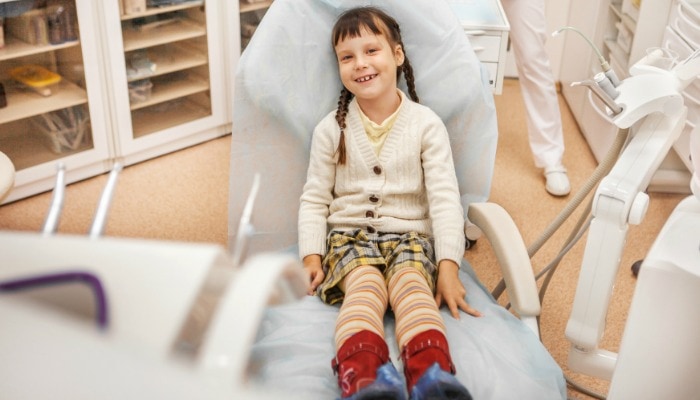
Minimize Exposure to Others’ Fears
Another thing I need to point out is that it’s helpful to minimize exposure to other people’s fears and negative ideas of the dentist. Fear is learned behavior, and dentistry is no exception.
Recently, I made dental appointments for all three of my children. My oldest, the one with a history of dental work, was not happy with this bit of news. While he was in front of his sister, he began to talk about how he didn’t want to get cavities filled and it would hurt. I immediately told him to be quiet and that we could talk about it later, but it was too late.
My daughters heard everything he said, especially my three year old, who began to ask questions about the dentist and it hurting. Argh. My son even tried to backtrack and tell her it wouldn’t hurt, but I just had him be quiet so he wouldn’t make this bad situation worse.
I attribute a lot of her apprehension, fear, and how upset she was at her cleaning (her one and only experience of dentistry) to hearing her brother share his feelings on the matter. I believe that if her mind weren’t tainted prior to her first appointment, things would have gone more smoothly. Live and learn!
Older Brother Memories
When I was a tween I had some tooth sensitivity and I thought I was going to have to get my first cavity filled (I didn’t). My brother found out about this and tormented me with made-up dental horror stories. He enjoyed filling me with fear! If your child has an older sibling that enjoys provoking and torture, preemptively have a conversation with them that goes something like this.
Parent: Your little sister has to get a cavity filled and will likely be very afraid. It would be more helpful for her if you did not talk with her about the dentist and only let mommy help.
Older Child: Ok.
In a perfect world, right? 😉
Answer Questions in Their Language
Sometimes well-meaning parents give too much information to children when answering questions. Instead, it’s more helpful to give only the information that’s requested and in their own language.
If your child asks if it’ll hurt, perhaps it would be best to have a conversation that goes a little something like this.
Child: Mom, will it hurt at the dentist?
Parent: A tiny bit, but I’ll be with you and you’ll be brave.
and not this
Child: Mom, will it hurt at the dentist?
Parent: It’ll hurt a tiny bit when the needle goes into your gums. But that’s ok because they’re giving you medicine to make your mouth numb which is important when they drill your teeth and fill your cavity. It would hurt much worse if you didn’t get the shot.
Do you see the difference?
Deepest Question
Kids don’t need a medical play-by-play, they need to know the bare minimum, and for their deepest questions to be answered which are often 1) will they be ok? and 2) can they do it?
Also, don’t dwell on the matter. Be matter of fact, concise, and drop it after a brief conversation. Don’t continually put the subject back on the table in an attempt to work through it at all angles or to make sure they’re ok. Follow your child’s lead and use age appropriate language when it comes to talking with them about their first cavity.
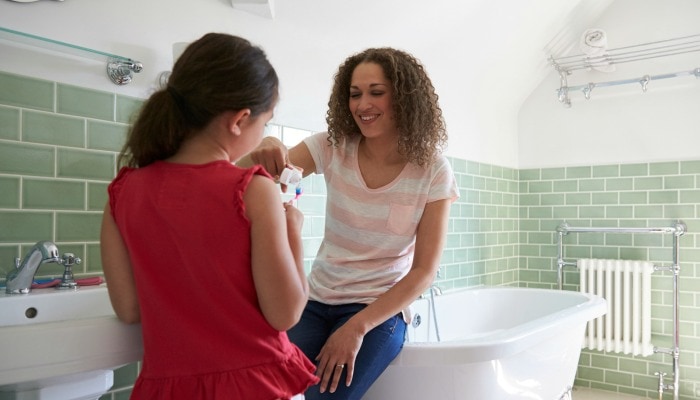
Use Bribery as a Tool
Here’s where helping a very young child with their first cavity gets interesting. Normally, I do not condone bribery as an effective parenting tool, however, when it comes to getting dental work done, I’m all about bribing the children.
A couple weeks before our appointment to get some cavities filled for the first time, I threw out the idea to my youngest that if she was brave and opened her mouth like a baby bird so the dentist could fix her tooth, she would get a prize.
Me: At our next dentist appointment, if you are brave and let the dentist clean and fix your tooth, mommy will buy you a prize at a store.
Daughter: What will I get?
Me: I’m not sure yet.
Daughter: *long pause* …Will you stay with me?
Me: Yes, I won’t ever leave you. You can sit on my lap while they look at your teeth. (I had no idea if this was a possibility, but where there’s a willful mama, there’s a way.)
You can see by her second question that she was, for the first time, allowing herself to think about letting the dentist in her mouth. She subsequently became worried and asked if I (the person in her life that helps her to feel safe) would be with her. THAT moment was pivotal.
When bribery is used you’ll typically get a child’s attention pretty quickly, which is helpful when explaining expectations of a particular situation. My three year old knew that she had to 1) be brave and 2) open her mouth to let the dentist fix her tooth.
Practical Application of Said Bribery
After the initial conversation about the reward, I didn’t bring it up again and my kids forgot about it. However, the night before our dentist appointment, right before bedtime (see their pjs in the photo below?), I took them to the store that had the sparkly thing that they wanted. In this instance the sparkly thing they were interested in was these little TY Beanie Boos.
I didn’t take her to the store days or weeks before her appointment because I didn’t want to continually talk about the matter, but I also wanted the image of her Beanie Boo FRESH in her mind at the next day’s 8 am appointment. I wanted to create feelings of excitement and anticipation while minimizing worry and anxiety.
Sparkly Things
In my opinion it’s best not to give food or candy rewards, especially for dental treatments. If possible, give your child something small but meaningful. Remember, if this bribe works and your child is able to undergo dental treatment without general anesthesia or a restraint, a toy is a small price to pay compared with the bill from an anesthesiologist or the trauma of a “papoose”. Also, it’s may be helpful to take a picture of them with their sparkly thing. Keep on reading to find out why.
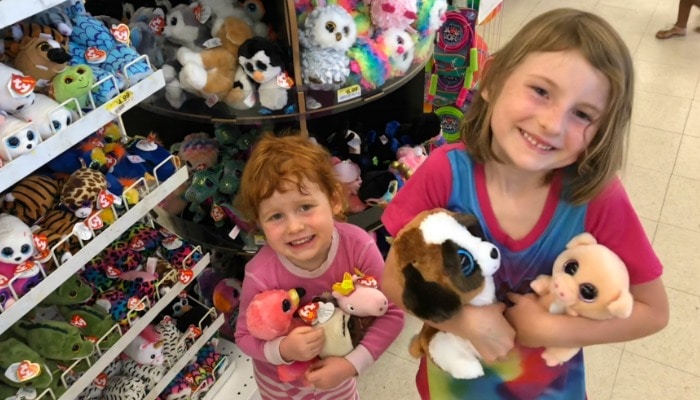
The following morning on our way to the dentist I showed my kids the picture with the Beanie Boos that they wanted. I reiterated to them what they had to do to get their sparkly thing 1) be brave and 2) open their mouth like a baby bird to let the dentist clean and fix their teeth). My expectations of them and their reward were fresh in their mind.
Spoiler Alert: My tactics worked. Keep reading for the rest of the story.
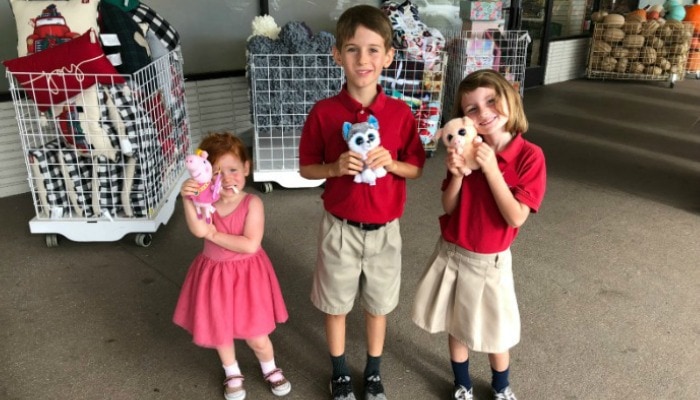
Know Your Child’s Needs
Once we got to the office I had a plan in mind about how this should go down. All three of my children needed fillings and two of the three needed a first filling. Both parents would be present. I had a plan in mind based on the individual needs of each child. Let me explain.
- For my oldest and the most experienced with dental shenanigans, I planned to send him off alone for the very first time. I didn’t think he would be pleased about this, but I knew that he would be able to cope with the disappointment of not having his dad with him but also being alone to get his filling done.
- For my middle child I planned to send her in with her dad. She definitely needed one-on-one attention from a parent, but I knew that my youngest child needed me more than my middle did.
- My youngest, and biggest concern since she’s so young, needed me the most. I went with her.
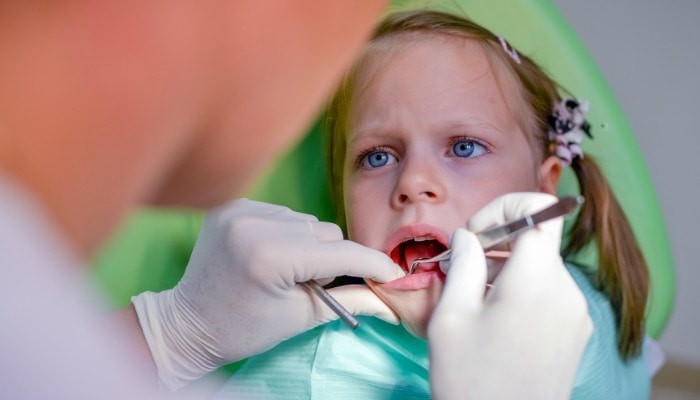
Should I Stay or Should I Go
Not all children do best with a parent or guardian present during their dental appointments. For whatever reason, some children behave better/differently when with other adults. Some children, on the other hand, thrive when their parent is present for their dental appointments.
If possible, find a dentist that will accommodate whatever it is that your child needs most. It’s important to be accommodating to the child, not necessarily to the convenience of the dentist.
All three of my children had appointments at exactly the same time, so all three were called at once (it’s a large office). It was quite the commotion shuffling off each child with their “team” of people. At that moment I scooped up my three year old as I knew she needed reassurance that I would stay with her the whole time.
Once we got in our room the dentist asked me to put Mercy in the chair. This is how that conversation went down.
Dentist: If you’ll put her in the dental chair, we’ll get started.
Me: I’m going to sit with her in the chair today. *sits down on chair with child on lap*
Dentist: We don’t usually do that.
Me: Well this is the only way this is going to happen. We can give it a try.
Dentist: If at any time you’re uncomfortable with how things are going you can always refuse treatment.
Me: Ok…
*reclines chair and begins treatment*
Me: *while holding her hands* Ok Mercy, we’re going to be brave and open our mouth like a baby bird so the dentist can fix your tooth.
Dentist: *while successfully fixing three year old’s tooth* I’ve never done this before.
Me: It’s good to try new things. Maybe this will help you with some of your other patients.
A few times during the procedure Mercy became wiggly and was clearly OVER IT, but I was right there to hold her hands firmly and remind her of her Peppa Pig beanie baby that would soon be hers. It freaking worked and in that moment I was so stinking proud of us!
The thing is, I know my three year old really well, and of course, I know her better than the dentist knows her. I also knew that by going about it the way I did, I would give her the best shot at successfully getting her first filling. I put on my mama bear hat and advocated for my child so that she could have what she needed to get it done. #parentingwin
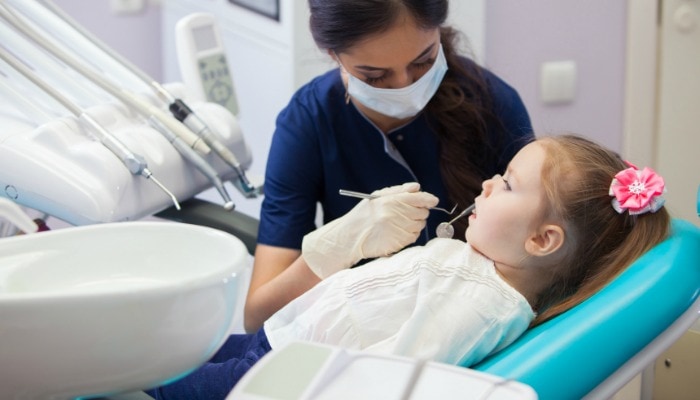
Sedation
Here are some final thoughts about sedation when it comes young children with their first filling.
Nitrous
Nitrous is given to children to help them relax during a dental appointment that’s more than just a filling. As a mother I’m ok with this. However, I do think it’s important to consider that it may wipe out your child’s B12 if they have MTHFR.
Medical Restraint
Some parents are faced with the option of using a medical restraint or a “papoose” during a child’s first filling. Honestly, as a mother, I have a really hard time with this. The reason the restraint is used is because the child cannot stay still enough for the dental work to be done. This seems traumatic to me, but I would be open to hearing people’s experiences with this. Leave a comment! I’d love to hear your story.
General Anesthesia
General anesthesia is a big deal, especially with the very young. However, if your child cannot stay still for the procedure, or the “papoose” isn’t working, general anesthesia may be the way to go. This is an expensive procedure, which is a barrier for some families. But for those that can afford it, it may be the most humane option for your child. One perk of this route is that you can knock out a bunch of dental work at one time, which is wonderful.
How To Help Young Children With Their First Filling
How have you helped your young child with their first filling? What worked and what didn’t work?
PLEASE leave a comment and share your experience. It takes a village to raise a child and dental work is no exception!

Catherine Beebe
Monday 24th of September 2018
I worked for 12 years as a restorative dental hygienist in a pediatric practice--I was the one getting kids numb and placing the fillings. Lots of great advice here--especially not giving more information than needed. We always advised parents to answer minimally or with "that's a great question for the dentist." Practitioners experienced in working with children will be able to explain things in a way that is honest but minimizes the scariness. Minimizing exposure from other's negative experiences is also huge. You are absolutely correct that many children behave differently without their parents. One thing I would like to add to this is when the parent is present, the child focuses on what the parent says. When the parent leaves, the dental team gets the child's undivided attention and we can talk them through so much! We did not use papoose boards, but would have someone sit in the chair with the child and hold their hands if needed--they could then restrain the child if need be. This was always for safety and never for behavior. We don't want the child or staff to get injured by flailing hands sending a drill, needle, or instrument flying!